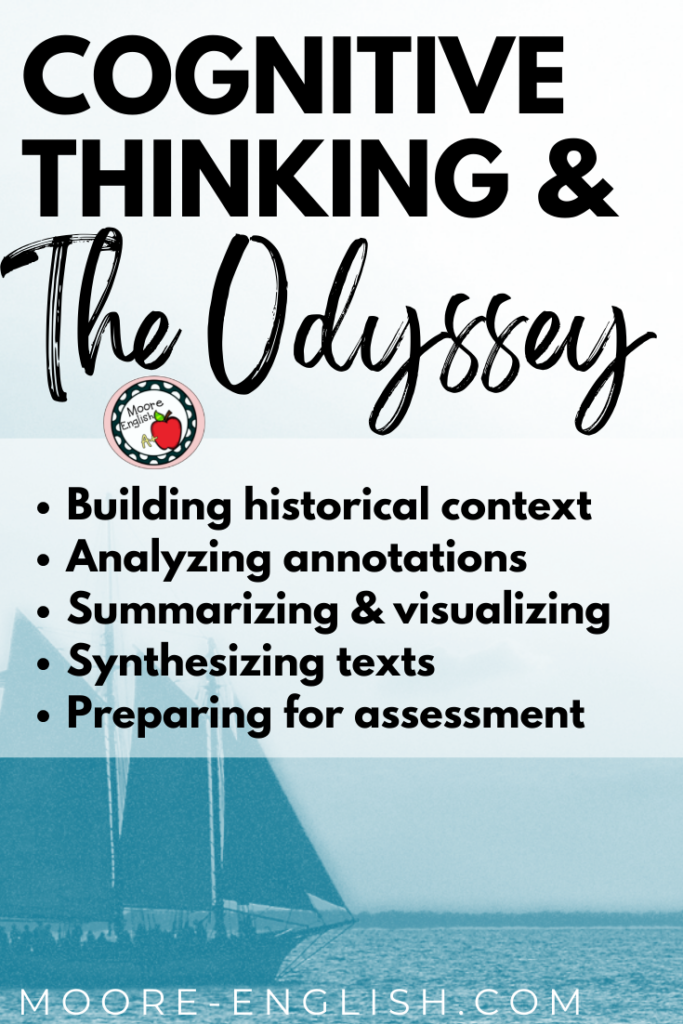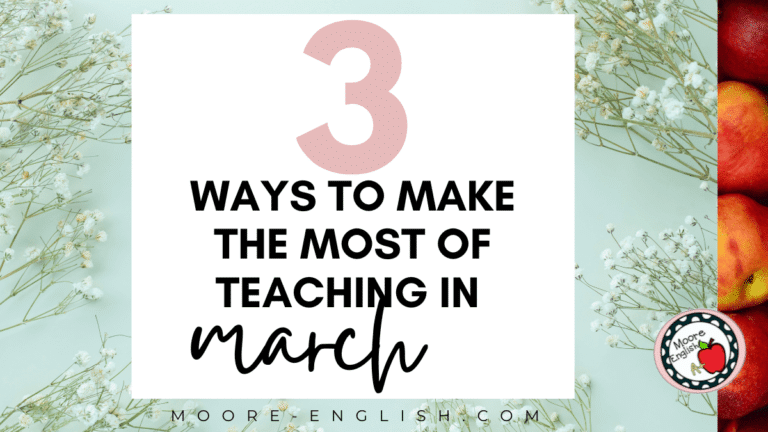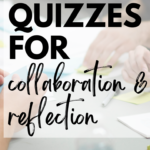A few weeks ago, I shared my favorite paired texts for teaching The Odyssey. Now that my unit on The Odyssey has finished, I wanted to share my favorite activities from the unit. Each activity focuses on one or two cognitive skills to help students successfully unpack The Odyssey.
This post this post may contain affiliate links. Please read the Terms of Use.
Engaging Students
Using essential questions is a great way to get students excited about a new text. For The Odyssey, I enjoy using this set of essential questions:
- Why is “home” an important idea?
- What does it mean to be a hero?
- When does pride become problematic?
- To what extent do humans control their own fates?
- Is the journey more valuable than the destination?
- What are the aspects of successful conflict resolution?
Essential questions are great because they are flexible. They can become journals, bell ringers, or the start to a great classroom conversation.
Similarly, anticipation guides can be a great way to get students focused on a new text. Grab my free anticipation guide for The Odyssey.
Building Context for The Odyssey
Before we begin reading The Odyssey, students need some background knowledge about Odysseus and about heroes. To build background knowledge for Odysseus, I pull up this map and tell students an abridged version of The Iliad. Depending on the group of students, I may ask students to take some notes or turn this into an opportunity for fast formative assessment. There are also some great YouTube videos with information for The Odyssey:
- Ted-Ed has “Everything you need to know to read Homer’s ‘Odyssey‘” Jill Dash. Grab my listening guide to make this an active listening experience!
- Crash Course Literature also has an episode about The Odyssey, and you can find my listening guide right here.
To build context for the idea of heroes, I ask student groups to brainstorm the characteristics of a hero. Then, students work with their small groups to read about well-known heroes and refine their list of characteristics of heroes. I use this set of free inquiry-based task cards to help students work through this activity.
Ted-Ed also has two more videos about heroes that you can show:
- “What makes a hero?” by Matthew Winkler
- “A host of heroes” by April Gudenrath

Analyzing with Annotations
Since my students read The Odyssey early in the semester, this is the text I use to build expectations for annotation. For this reason, the early sections of the text are where I help students unpack the idea of annotating the text, help them choose symbols and markers for annotation, and where I model and talk aloud my thinking as I annotate the text. Here’s the schedule I use for this process:
- The Poet Prays: This is a relatively short passage, so I read this entire passage aloud to my students. Then, I read the passage aloud a second time, stopping to annotate the text and to think aloud to model my process for marking the text. Students mark my annotations on their papers too and then use the annotations to answer the reading questions. This resource is free, too! Get it here.
- Calypso: For this passage, I read the passage aloud in stanzas. For the first stanza or two, I DO. In the third or fourth stanza, YOU TWO DO. Then, I have each pair share out one of their meaningful annotations. Next, YOU DO, and students annotate independently. If we have time, students might pair-share before we do this. Then, students can work in partners to complete the questions.
- The Lotus Eaters: This is a short episode in The Odyssey, so it’s a great place for students to independently practice annotations. This is my opportunity to get formative data from my students. First, students’ independent annotations give me insight into their ability to interact with a text meaningfully. Second, their independent answers to the reading questions let me know the efficacy of their annotations as well as their level of reading comprehension.
- The Cyclops: Unlike the Lotus Eaters, this is a very long episode! For this reason, this is a great place to differentiate. The previous episode gives me formative data about my students, and the length of this episode lets me respond to that data. For me, this usually means breaking my class into groups: the reteaching group, the on-level group, and the enrichment group. I will read at least the first half of this with the reteaching group. In the on-level group, students will complete the work independently or in partners. And in the enrichment group, I will challenge students to complete a few task cards after they read.
Summarizing and Visualizing
As a new teacher, I never suspected that visualizing would become such an important strategy for my students. However, experience has taught me time and time again that students are better able to make connections when they visualize text. With this in mind, students created comic strips to help them visualize and summarize episodes from The Odyssey.
To facilitate this process, I gave each group a piece of chart paper that students folded into sixths. Each group was responsible for one of the middle episodes in The Odyssey: Circe, the Land of the Dead, Circe’s Warning, Scylla and Charybdis, or the Sirens.
One of the things I appreciate about this activity is that it asks students to use a variety of skills. They have to read and comprehend the text, determine how to “package” the episode into six comic-style panels, and find a way to use the comic structure to compellingly tell the story. Here’s the assignment sheet and rubric I use for this activity. Follow the link, make a copy, and you’ll have the assignment sheet and rubric ready to use!
Synthesizing The Odyssey
To promote synthesis thinking, I introduced students to different poems related to The Odyssey. Depending on the class size, I did a “book talk” on 5-6 poems related to the epic. Students then determined which poem interested them the most. For example, students who most enjoyed The Cyclops section wanted to read Nikki Giovanni’s poem “The Cyclops in the Ocean.” However, students interested in the romantic aspects of The Odyssey were drawn to Suzanne Vega’s “Calypso.”
Once students were in groups, I gave each group a piece of chart paper with their poem glued in the middle. Students then used their annotations from earlier in the unit to annotate the text on the chart paper. In the space around the poem, students wrote down connections between the poem and The Odyssey or asked questions about the poem.
Then, students rotated from chart to chart, reading poems and adding to their classmates’ annotations. Once each student had visited each poem, students returned to their original groups to discuss reoccurring ideas, images, or symbols from the poems. As a class, we made a list of these commonalities on the board and then began turning ideas into themes. This allowed students to craft themes they had not previously associated with The Odyssey.
Preparing for Assessment
As you can probably tell from the activities above, the summative assessment for this unit focuses on context clues, figurative language, summary, and inference. In my district, each unit must end with a multiple-choice test that’s common to the entire team district wide. In ELA, this also means cold reads of pieces unrelated to the unit. With this in mind, I wanted to help students prepare for the assessment. To begin, I wanted to make sure students would be familiar with the types of questions they’d see on the test. I also wanted to incorporate movement into the process.
First, students chose groups of 3, and I assigned students one of the passages from the end of the epic: Homecoming, Penelope’s Suitors, Penelope, The Contest, Odysseus’ Revenge, or Penelope’s Test.
Then, I gave each group a piece of chart paper. Each group folded their paper into fourths, using the top two squares to summarize their passage. In this unit, we have been focused on the somebody-wanted-but-so method for summary. In the bottom left square, students wrote a context-clues style question from their passage. For the bottom right, students wrote a figurative-language question. In both instances, I wrote question stems on the board for students, and I asked students not to write the answer on their chart but to make sure that they could explain the correct answer to their classmates.
It took students a class and a half to create their posters. At the end of the second day, we hung the posters around the room in chronological order. On the third day, students visited each poster with their group and wrote down what they believed to be the correct answer. This took about half the class. In the second half of class, each student group read out their summary and explained the correct answers to their questions.
Overall, this proved to be an effective way for students to finish The Odyssey and provided them with an opportunity to review the skills on the assessment.

















